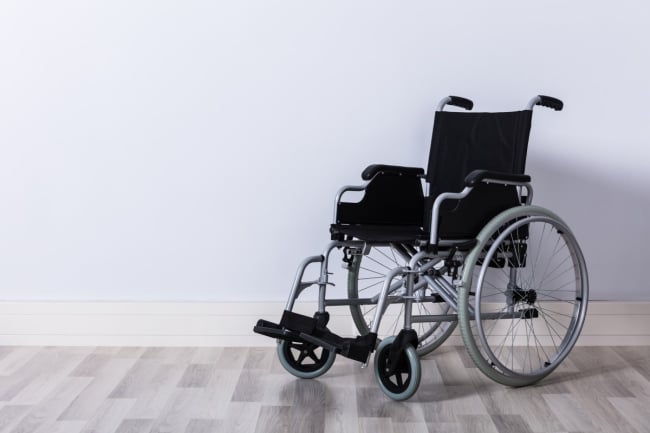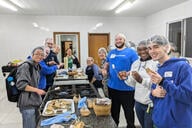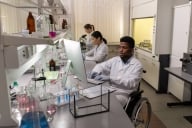You have /5 articles left.
Sign up for a free account or log in.

iStock
The bathroom in the University of Maryland, College Park’s South Campus dining hall is on the third floor, up a couple flights of steps. But students in wheelchairs can’t reach it the way most students would. They need to take a side entrance, up an elevator -- where they’ll find that the restroom door isn’t powered by an automatic opener and isn’t even large enough to accommodate some of their wheelchairs.
This is just one student testimonial in a more than 20-page report detailing deficiencies with accommodations for students with physical disabilities at College Park.
While a wheelchair lift and a new bathroom are being installed at the South Campus dining hall, the report lists many more examples of inaccessible bathrooms and buildings at the state’s flagship institution, as well as crosswalks without the necessary ramps for wheelchairs. The report does not discuss technology accommodations.
While colleges and universities in many cases are keen to help students with their individual accommodations, campuswide projects that help students with physical disabilities are sometimes lacking, despite requirements by the federal Americans With Disabilities Act of 1990.
“As accessibility standards have changed over time, we will continue to evaluate the campus landscape and facilities,” Natifia Mullings, a College Park spokeswoman, said in a statement. “Our aim is to address accessibility concerns so that we can create an inclusive campus for all students, faculty and staff.”
The report was created by Adith Thummalapalli, a student who uses a wheelchair. Thummalapalli, who did not respond to repeated requests for comment, was almost unable to get to his classes in the J. M. Patterson building for weeks earlier this year when the elevator there went down for maintenance. Thummalapalli would need to call a representative in Facilities Management, who would meet him at the elevator, pry open the doors by hand and take him up. Thummalapalli was unaware the elevator was being fixed when the semester began. The university has since changed its protocol to notify Accessibility and Disability Service of all maintenance around campus.
The Student Government Association took notice of Thummalapalli’s work and passed a resolution to publish the report and use its findings to push the administration to make the campus more accessible. Student government representatives did not respond to requests for comment.
Mullings said that the report was “reviewed” -- she did not elaborate how or by whom -- and said, “We want to hear from members of the community who are experiencing accessibility issues on campus so that we can better understand their current accessibility needs and concerns.”
In addition to the inaccessible bathroom at the South Campus hall, the report identifies problematic restrooms in several academic building, as well as the Adele H. Stamp Student Union and McKeldin Library. Mullings said at least one new accessible bathroom is being created -- in the biology/psychology building.
The report also found that at least 10 campus crosswalks lacked at least one of the ramps that enable people using wheelchairs to safely navigate from the sidewalk onto a roadway.
At least four dormitories on the campus are also not accessible, the report states. The buildings, which are on the south side of campus, all opened in the 1940s (as most of the buildings on campus did) and take advantage of an exception with ADA standards -- they are thus legally compliant.
But the report states that it is “morally deceptive” to call them accessible. At one, Kent Hall, only a side entrance in the basement doesn’t have stairs leading to the door.
“No infrastructural changes can really be made in these old buildings, but UMD should not claim that they are ADA-accessible when so many other buildings actually deserve that designation,” the report reads.
Many of the issues the report identifies have also been tracked in the university’s ADA Transition Plan, which the law requires. Institutions must identify barriers for students with disabilities and then develop a strategy for how to eliminate those barriers. The university’s initial plan was prepared in 2000 and updated most recently in 2016.
From 2013 to 2016, the university spent more than $2 million on physical improvements to the campus, largely in restroom upgrades. Officials intend to spend at least $43 million on construction for disability accommodations, again mostly on bathrooms and elevators.
Some on the campus have praised the university administration for helping students with physical disabilities -- specifically for the “Will You Stand Up for Me?” campaign out of the college’s Department of Transportation that encouraged bus riders to move from their seats for people who needed them most. But other students have been more critical.
In the campus newspaper, The Diamondback, one student, Liyanga de Silva, wrote that “people with disabilities shouldn’t be an afterthought.”
She was particularly harsh on the administration for Thummalapalli’s encounter with the elevators. De Silva wrote that the College Park campus is already hard to navigate because it’s so large and hilly. But she wrote that the issues with Thummalapalli illustrate a much larger problem.
“Why didn’t anyone consider the impact an elevator outage would have on Thummalapalli and other students who use wheelchairs? It seems like a pretty logical conclusion to make, but because no one made it, students with disabilities were treated as an afterthought,” she wrote.
“I appreciate Facilities Management’s attempts to accommodate Thummalapalli by telling him that if he needed the elevator, an employee would come and open it for him. However, even that backup plan meant he could still be 10 to 15 minutes later to his class than his able-bodied classmates. A simpler solution to this issue is better communication between the parties and departments involved.”




